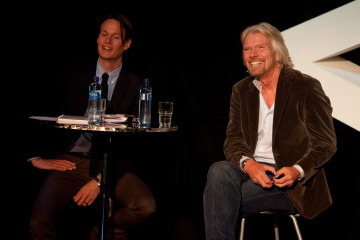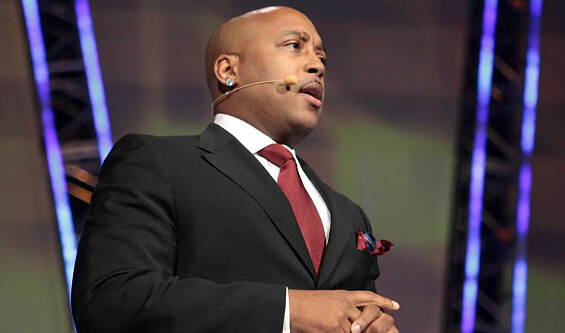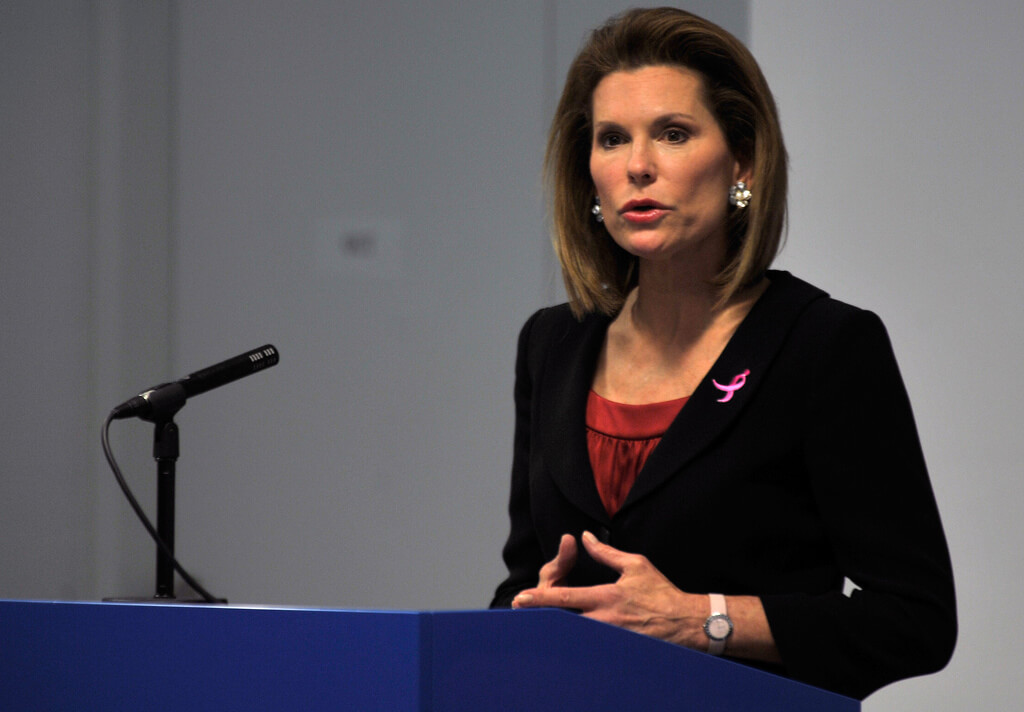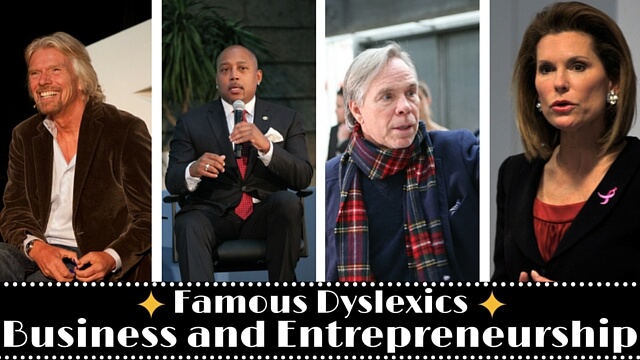Famous Dyslexics : Business and Entrepreneurship
Business and Entrepreneurship
A 2007 survey done by NY Times revealed that about 1/3 of surveyed business owners identified as dyslexic. Entrepreneurs and dyslexics often share some of the same skills, such as problem solving, persistence, creativity, and ability to look at the bigger picture. These are all positive attributes that can be turned into opportunities if seen as such. The following entrepreneurs and business people did just that.
Richard Branson
“Being dyslexic can actually help in the outside world. I see some things clearer than other people do because I have to simplify things to help me and that has helped others.”
 British billionaire Richard Branson is the founder and CEO of Virgin Group. The entrepreneur dropped out of school at sixteen partly due to the struggles he faced with dyslexia. Teachers thought he was lazy because he did not work the same way his peers did. Realizing that the classroom was not the right environment for him, he used his entrepreneurial drive to begin publishing at the age of sixteen. Richard later went on to launch several branches of what would eventually become Virgin Group, including Virgin Records, Virgin Atlantic and Virgin America airlines. In order to succeed in the business industry, Richard adapted his management style to the mechanics of his learning disability. Thanks to his dyslexia, he developed strong delegation abilities and was able to better focus his skills when applying them to different projects. As a dyslexic, Richard prefers everything to be simple and clear-cut. By making sure his business followed these guidelines, he created a brand that is known for having a superior and clear communication strategy that draws in customers. The entrepreneur says he never saw his condition as a disability, but rather a gift. This positive outlook is what drove him to become a powerful businessman and a strong advocate for those with dyslexia.
British billionaire Richard Branson is the founder and CEO of Virgin Group. The entrepreneur dropped out of school at sixteen partly due to the struggles he faced with dyslexia. Teachers thought he was lazy because he did not work the same way his peers did. Realizing that the classroom was not the right environment for him, he used his entrepreneurial drive to begin publishing at the age of sixteen. Richard later went on to launch several branches of what would eventually become Virgin Group, including Virgin Records, Virgin Atlantic and Virgin America airlines. In order to succeed in the business industry, Richard adapted his management style to the mechanics of his learning disability. Thanks to his dyslexia, he developed strong delegation abilities and was able to better focus his skills when applying them to different projects. As a dyslexic, Richard prefers everything to be simple and clear-cut. By making sure his business followed these guidelines, he created a brand that is known for having a superior and clear communication strategy that draws in customers. The entrepreneur says he never saw his condition as a disability, but rather a gift. This positive outlook is what drove him to become a powerful businessman and a strong advocate for those with dyslexia.
Daymond John
“My mother always said, ‘It takes the same energy to think small as it does to think big,’…So dream big and think bigger.”
 Shark Tank investor and entrepreneur Daymond John knew from a young age that his strengths were creativity and analytical thinking, but he had to first overcome hurdles to finally harvest those talents. In school, Daymond had a hard time with reading and spelling. His parents often got frustrated, as they believed he just wasn’t applying himself. After watching her child struggle academically, Daymond’s mother worked closely with her son on a daily basis to help develop his abilities. Knowing that reading and writing were his weak points, Daymond worked hard to be exceptional at what he was already good at. This ideal brought him to enroll in a co-op high school program, which would allow him to work full-time one week and do his schooling the next. With great work experience under his belt, he later went on to create FUBU, an influential clothing line that has helped the entrepreneur garner many awards. Daymond did not get a diagnosis for his dyslexia until he was an adult, but he says he found his success by never letting his weaknesses define him. Drive and determination are what helped him transfer his creativity and analytical thinking skills into successful entrepreneurial ventures.
Shark Tank investor and entrepreneur Daymond John knew from a young age that his strengths were creativity and analytical thinking, but he had to first overcome hurdles to finally harvest those talents. In school, Daymond had a hard time with reading and spelling. His parents often got frustrated, as they believed he just wasn’t applying himself. After watching her child struggle academically, Daymond’s mother worked closely with her son on a daily basis to help develop his abilities. Knowing that reading and writing were his weak points, Daymond worked hard to be exceptional at what he was already good at. This ideal brought him to enroll in a co-op high school program, which would allow him to work full-time one week and do his schooling the next. With great work experience under his belt, he later went on to create FUBU, an influential clothing line that has helped the entrepreneur garner many awards. Daymond did not get a diagnosis for his dyslexia until he was an adult, but he says he found his success by never letting his weaknesses define him. Drive and determination are what helped him transfer his creativity and analytical thinking skills into successful entrepreneurial ventures.
Tommy Hilfiger
“I performed poorly at school – when I attended, that is – and was perceived as stupid because of my dyslexia.”
 Tommy Hilfiger, founder of the popular lifestyle brand Tommy Hilfiger, always knew he was different from the other designers in the fashion industry. He first noticed his learning disability in school when he received low grades on assignments. Because of his poor academic performance, his teachers simply thought he was unintelligent and never took the time to seriously diagnosis what was causing him to struggle. Instead of pursuing a higher education after high school, Tommy moved to New York City to work within the retail industry. At the age of eighteen, he opened his own storefront. Despite the store going bankrupt, the designer showed perseverance and went on to do freelance work for other well-known designers. These opportunities are what led to the founding of his own company, which has continued to remain popular for over twenty years. He believes his lack of formal training is what allowed him to have a viewpoint on design that differed from that of his colleagues. Tommy still has trouble reading and has to take time to concentrate to accomplish the task, but taking his own path has taught him how to use his struggles as tools for success rather than sources of frustration.
Tommy Hilfiger, founder of the popular lifestyle brand Tommy Hilfiger, always knew he was different from the other designers in the fashion industry. He first noticed his learning disability in school when he received low grades on assignments. Because of his poor academic performance, his teachers simply thought he was unintelligent and never took the time to seriously diagnosis what was causing him to struggle. Instead of pursuing a higher education after high school, Tommy moved to New York City to work within the retail industry. At the age of eighteen, he opened his own storefront. Despite the store going bankrupt, the designer showed perseverance and went on to do freelance work for other well-known designers. These opportunities are what led to the founding of his own company, which has continued to remain popular for over twenty years. He believes his lack of formal training is what allowed him to have a viewpoint on design that differed from that of his colleagues. Tommy still has trouble reading and has to take time to concentrate to accomplish the task, but taking his own path has taught him how to use his struggles as tools for success rather than sources of frustration.
Nancy Brinker
“I was such a hard worker all my life. I wasn’t stupid by any means, I had the intelligence, but I couldn’t learn the way other people did”
 Nancy Brinker, founder of Susan G Komen for the Cure, struggled with reading, writing, and math, but this wasn’t obvious to her teachers and parents. Despite facing hardships in the subjects, Nancy learned how to use memorization to her benefit at a young age and, as a result, performed at the same level of her peers in the classroom. It wasn’t until standardized testing came along that Nancy’s parent realized something wasn’t right. Nancy knew how to memorize numbers and facts, but she couldn’t use logical methods like the test questions required. Even though standardized tests were a wake-up call, Nancy was never diagnosed with a learning disability. It wasn’t until her own son was diagnosed with dyslexia that she realized many of her symptoms were the same. Despite all of this, Nancy has gone on to create one of the most well-known breast cancer foundations and win the Presidential Medal of Freedom, the highest civilian honor given in the United States. Nancy found her success by focusing on her strengths in visual learning and growing from doing and experiencing, rather than reading. As for advice for young dyslexics that have some of the same troubles, Nancy encourages all children to find their passion and pursue what they love to do.
Nancy Brinker, founder of Susan G Komen for the Cure, struggled with reading, writing, and math, but this wasn’t obvious to her teachers and parents. Despite facing hardships in the subjects, Nancy learned how to use memorization to her benefit at a young age and, as a result, performed at the same level of her peers in the classroom. It wasn’t until standardized testing came along that Nancy’s parent realized something wasn’t right. Nancy knew how to memorize numbers and facts, but she couldn’t use logical methods like the test questions required. Even though standardized tests were a wake-up call, Nancy was never diagnosed with a learning disability. It wasn’t until her own son was diagnosed with dyslexia that she realized many of her symptoms were the same. Despite all of this, Nancy has gone on to create one of the most well-known breast cancer foundations and win the Presidential Medal of Freedom, the highest civilian honor given in the United States. Nancy found her success by focusing on her strengths in visual learning and growing from doing and experiencing, rather than reading. As for advice for young dyslexics that have some of the same troubles, Nancy encourages all children to find their passion and pursue what they love to do.
Ensure your child’s success by getting them the help they need. You can screen your child for dyslexia with our free dyslexia screener.
Photo Credits (some photos have been modified): Flickr.com – Jarle Naustvik, U.S. Embassy Nairobi, 4hourworkweek, Kunstakademiets Designskole , IAEA Imagebank
Improve Your Child’s Reading
Learn more about Lexercise today.
15-minute consultation
Eryn Feeney
Eryn Feeney is currently a student at North Carolina State University studying Fashion and Textile Management and Arts Entrepreneurship. As Lexercise’s social media intern, she is responsible for collecting and creating content, developing social media campaigns, scheduling social media posts across all platforms, and analyzing the performance of all social media channels. Passionate about brand marketing and management, Eryn most enjoys creating an online experience that gives Lexercise the opportunity to engage with families on a personal level.



Leave a comment